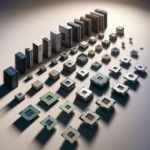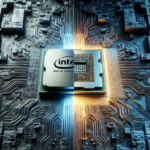The Evolution of CPU Technology Over the Years

The Evolution of CPU Technology Over the Years
The Central Processing Unit (CPU) is often referred to as the brain of the computer. It is responsible for executing instructions and processing data, making it a critical component in any computing device. Over the years, CPU technology has undergone significant transformations, driven by advancements in semiconductor technology, architectural innovations, and the ever-increasing demand for higher performance and efficiency. This article delves into the evolution of CPU technology, tracing its journey from the early days to the present and beyond.
Early Beginnings: The Birth of the CPU
The First Generation: Vacuum Tubes
The first generation of computers, which emerged in the 1940s, relied on vacuum tubes for processing. These early machines, such as the ENIAC (Electronic Numerical Integrator and Computer), were massive, power-hungry, and prone to frequent failures. Despite their limitations, they laid the groundwork for future developments in computing.
The Second Generation: Transistors
The invention of the transistor in 1947 by John Bardeen, Walter Brattain, and William Shockley marked a significant milestone in CPU technology. Transistors were smaller, more reliable, and more energy-efficient than vacuum tubes. The second generation of computers, which appeared in the 1950s and 1960s, utilized transistors, leading to more compact and efficient machines.
The Integrated Circuit Revolution
The Third Generation: Integrated Circuits
The 1960s saw the advent of integrated circuits (ICs), which allowed multiple transistors to be placed on a single silicon chip. This innovation led to the development of the third generation of computers. ICs significantly reduced the size and cost of computers while increasing their reliability and performance. The IBM System/360, introduced in 1964, was one of the first computers to use ICs and became a commercial success.
The Fourth Generation: Microprocessors
The introduction of the microprocessor in the early 1970s marked the beginning of the fourth generation of computers. A microprocessor is a single-chip CPU that integrates all the functions of a central processing unit. The Intel 4004, released in 1971, was the world’s first commercially available microprocessor. It was followed by the Intel 8008 and the more famous Intel 8080, which became the foundation for the personal computer revolution.
The Rise of Personal Computing
The 1980s: The Era of Personal Computers
The 1980s witnessed the rise of personal computers (PCs), driven by advancements in microprocessor technology. Intel’s 8086 and 8088 processors powered the first IBM PCs, which became immensely popular. The introduction of the x86 architecture set the stage for future developments in CPU technology.
RISC vs. CISC
During this period, two competing CPU architectures emerged: Reduced Instruction Set Computing (RISC) and Complex Instruction Set Computing (CISC). RISC processors, such as those developed by ARM and MIPS, focused on simplicity and efficiency, while CISC processors, like those from Intel, aimed to execute complex instructions directly. Both architectures have their strengths and weaknesses, and the debate between RISC and CISC continues to this day.
The 1990s: The Age of Performance
Clock Speed and Moore’s Law
The 1990s were characterized by a relentless pursuit of higher clock speeds and performance. Moore’s Law, which predicted that the number of transistors on a chip would double approximately every two years, held true during this period. This led to exponential growth in CPU performance. Intel’s Pentium processors, introduced in 1993, became synonymous with high performance and set new standards for personal computing.
Multicore Processors
As clock speeds approached their physical limits, CPU manufacturers began exploring multicore processors. By integrating multiple processing cores on a single chip, CPUs could handle more tasks simultaneously, improving overall performance and efficiency. The first dual-core processors appeared in the mid-2000s, and today, multicore processors with four, six, eight, or more cores are common in both consumer and enterprise markets.
The 21st Century: Innovations and Challenges
Power Efficiency and Thermal Management
With the increasing demand for mobile and portable devices, power efficiency and thermal management became critical concerns. CPU manufacturers focused on developing energy-efficient architectures and advanced cooling solutions. Technologies such as Intel’s SpeedStep and AMD’s Cool’n’Quiet dynamically adjust the processor’s clock speed and voltage to balance performance and power consumption.
Advanced Manufacturing Processes
The transition to smaller manufacturing processes has been a key driver of CPU advancements. From the 90nm process in the early 2000s to the current 5nm and even 3nm processes, smaller transistors allow for higher performance, lower power consumption, and increased transistor density. However, shrinking transistors also presents challenges, such as increased leakage currents and manufacturing complexities.
Specialized Processing Units
In addition to general-purpose CPUs, specialized processing units have gained prominence. Graphics Processing Units (GPUs), originally designed for rendering graphics, are now widely used for parallel processing tasks such as machine learning and scientific simulations. Similarly, Field-Programmable Gate Arrays (FPGAs) and Application-Specific Integrated Circuits (ASICs) offer tailored solutions for specific workloads, providing higher performance and efficiency.
Future Trends in CPU Technology
Quantum Computing
Quantum computing represents a paradigm shift in computing technology. Unlike classical computers, which use bits to represent data as 0s or 1s, quantum computers use qubits, which can represent both 0 and 1 simultaneously. This allows quantum computers to solve certain problems exponentially faster than classical computers. While still in its infancy, quantum computing holds immense potential for fields such as cryptography, optimization, and drug discovery.
Neuromorphic Computing
Neuromorphic computing aims to mimic the structure and function of the human brain. By emulating neural networks, neuromorphic processors can perform tasks such as pattern recognition and sensory processing more efficiently than traditional CPUs. Companies like Intel and IBM are actively researching and developing neuromorphic chips, which could revolutionize artificial intelligence and machine learning applications.
3D Stacking and Heterogeneous Computing
To overcome the limitations of traditional planar chip designs, researchers are exploring 3D stacking, where multiple layers of transistors are stacked vertically. This approach can increase transistor density and improve performance. Additionally, heterogeneous computing combines different types of processors, such as CPUs, GPUs, and FPGAs, on a single chip to optimize performance for diverse workloads.
FAQ
What is the difference between RISC and CISC architectures?
RISC (Reduced Instruction Set Computing) and CISC (Complex Instruction Set Computing) are two different CPU architectures. RISC focuses on simplicity and efficiency by using a small set of simple instructions, while CISC aims to execute complex instructions directly. RISC processors are generally more power-efficient, while CISC processors can handle more complex tasks with fewer instructions.
What is Moore’s Law, and is it still relevant?
Moore’s Law, proposed by Gordon Moore in 1965, states that the number of transistors on a chip would double approximately every two years, leading to exponential growth in CPU performance. While Moore’s Law has held true for several decades, it is becoming increasingly challenging to maintain this pace due to physical and manufacturing limitations. However, advancements in materials, design, and manufacturing processes continue to drive CPU innovation.
What are the benefits of multicore processors?
Multicore processors integrate multiple processing cores on a single chip, allowing them to handle more tasks simultaneously. This improves overall performance, especially for multitasking and parallel processing workloads. Multicore processors also offer better power efficiency, as individual cores can be powered down when not in use.
How do specialized processing units like GPUs and FPGAs differ from CPUs?
GPUs (Graphics Processing Units) and FPGAs (Field-Programmable Gate Arrays) are specialized processing units designed for specific tasks. GPUs excel at parallel processing and are widely used for graphics rendering, machine learning, and scientific simulations. FPGAs can be reprogrammed to perform specific functions, offering high performance and efficiency for tailored workloads. In contrast, CPUs are general-purpose processors designed to handle a wide range of tasks.
What is quantum computing, and how does it differ from classical computing?
Quantum computing uses qubits, which can represent both 0 and 1 simultaneously, allowing quantum computers to solve certain problems exponentially faster than classical computers. Classical computers use bits to represent data as 0s or 1s. Quantum computing holds immense potential for fields such as cryptography, optimization, and drug discovery, but it is still in its early stages of development.
Conclusion
The evolution of CPU technology has been a remarkable journey, marked by continuous innovation and relentless pursuit of higher performance and efficiency. From the early days of vacuum tubes and transistors to the advent of microprocessors and multicore architectures, CPUs have transformed the way we live and work. As we look to the future, emerging technologies such as quantum computing, neuromorphic computing, and 3D stacking promise to push the boundaries of what is possible. The CPU will continue to be at the heart of computing, driving progress and enabling new possibilities in the digital age.




